The college golf postseason passes all too quickly. There’s an incredibly slow buildup as Fall season gives way to Winter break gives way to the Spring season, and then all of a sudden it's time for Conference/Regional/National play. The end is painfully abrupt no matter where in that sequence you finish. The heartache lingers, of course, but there’s hardly any time to truly savor the moment. In a practical sense, it’s the Doppler effect applied to the athletic experience, where that siren of anticipation reaches a fevered pitch as the moment races past and dissipates too fast to grasp.
Here in the library of college golf’s history, though, we take the time to reflect and relish. You’re invited to have a seat, pour a beverage, and peruse to your heart’s content.
This volume is the 2025 Men’s D1 Regional Roundup and in it you'll find a wealth of links (underlined text) and results.
*Note 1: because of the many pictures and links, this is best viewed on the website HERE. You can also use that link to come back and visit anytime!
**Note 2: each team photo is credited to their respective athletic department unless otherwise noted. Each photo of the teams and individuals participating in the regionals are from the NCAA/NBC Golf Channel Selection Show. And finally, all of the pictured results are courtesy of Scoreboard (powered by Clippd).
MEN’S REGIONALS [May 13-15, 2024]
**Read many great details from Brentley Romine [NBC Sports/Golf Channel] and Cameron Jourdan [Golfweek]
OVERALL IMPRESSIONS & STATS
Regionals were good for the #1 and #2 seeds this year, each only suffering one upset - combined 2 of the 10 total across all Regionals. Compare that to last year when those two seeds accounted for more than half of the 9 total upsets. As has been increasingly the trend the last several years, the 5 and 6 seeds - which represents the cutline of teams “expected to advance” based on seeding - are essentially interchangeable, and even the 7-9 seeds each had a 33% advancement rate (2 teams from each of those seeds). This being a zero-sum game, these upsets meant an equal number of higher seeds went home. The big headlines were about #1 seeded LSU not making it out of Amherst, but the larger storyline may be on half the #3 seeds falling short, giving them the same 50% advancement rate as the #5 and #6 seeds! Last year all of the #3 seeds advanced and as a group they had more wins (3) than the #1 seeds (2), however this year it was the #2 seeds with as many victories (3) as the #1 and #3 seeds combined. Let’s dive further into some overall stats:
All three host teams were seeded in the top 3 of their respective Regionals and all three (co-)won at home
Second time (2021) that 3+ hosts all won
It’s obvious that home-course advantage is huge and we can see that play out in the data table below where each of the hosts gained at least 1 stroke per player per round over what the other teams in their respective seeds gained over the field average
Weird trend: this is the THIRD year in a row that a host team has had an under-par drop score in the 1st round
2025 FSU rd1 drop score was 71/-1
2024 UNC rd1 drop score was 69/-1
2023 Michigan rd1 drop score was 70/-1
Experience reigned supreme as only one of the winning teams this year earned their first Regional title in team history
Amherst = Oklahoma won their 8th
Auburn = Auburn won their 5th
Bremerton = Florida won their 7th
Reno = BYU won their 1st
Tallahassee = FSU won their 2nd
Urbana = Illinois won their 7th and Oklahoma State won their 17th
This is the second year in a row that a #1 seed failed to advance
Just the 6th time since 2009
LSU has the unfortunate distinction of being the only team to have done that twice (2018)
This was the year of the #2 seeds, with Florida, FSU, and Oklahoma all winning team titles
First year since at least 2000 that more than TWO #2 seeds won
Only 14 #2 seeds had won a Regional from 2000-24, the most recent being Georgia Tech in 2023
Weirdly enough, in the last four years there have been SEVEN #2 seeded teams who were outside the top5 thru the first 18 holes and only ONCE (2023 eventual NCAA champs Florida) have they gone on to advance
UNC continued that trend this year, ranked 11th thru 18 and almost made a comeback before falling just short to finish 6th
BYU became the SIXTH #6 seed to win a Regional since 2009 (the start of the six site regional era)
2025 BYU, 2023 Georgia, 2022 Arizona, 2013 Illinois, 2012 Chattanooga, and 2012 Liberty
In total there were TEN upsets of top 5 seeded teams failing to advance
This is tied for most since 2009 (2023, 2017, 2012)
Breakdown:
Missed: #1 seed = 1, #2=1, #3=3, #4=2, #5=3
average finish = 7th, mode = 6th
Advanced: #6 seed = 3, #7=2, #8=2, #9=2, #12=1
average finish = 3.6, mode = 4th
Augusta became just the THIRD #12 seed to advance since 2009, ironically they were also the most recent
2025 = Augusta, 2018 = Augusta, 2009 = San Diego
There have been NINETEEN double-digit seeded teams to advance since 2009, none of them seeded lower/worse than 12th
Individuals competing without their team showed out this year
With Hunter Thomson [Michigan] and Ryan Ford [Cincinnati] finishing 1-2 in the Urbana Regional and Sakke Siltala [Texas State] finishing T2 in the Reno Regional, it was the THIRD time since 1989 that 3+ individuals finished in the top2 in the single year
WHERE HAVE ALL THE TROPHIES GONE?
You’ll notice that none of the Regional victors are pictured with a trophy this year. This was an intentional change made by the Join Committee at the end of last season, choosing instead to give trophies to the NCAA semifinalists. While the decision is understandable - at least when considering those were apparently the only two options - but it still seems like perhaps the winning teams should get something special to recognize this incredible accomplishment.
AUBURN, AL [Auburn]
You’d expect Auburn to show up big at home, but the Tigers somehow exceeded all expectations in their 27 stroke victory. Not only was this historic as the second-highest margin of victory in Regional history (1989-2025), they made more history as the first team ever with four players finishing in the top 5 **and** first ever with all 5 teammates finishing inside the top 15. Despite already leading through 36 holes, the Tigers undoubtedly made Coach Clinard proud with their exceptionally strong closing round 275/-13 which was 21.38 strokes better than the field average (another Regional historical record!1). Auburn was led by the superstar sophomore Jackson Koivun who joined a list of 15 other Haskins winners (2024) to medal in a Regional; interestingly, he became the first to gain his medal in the year(s) AFTER winning his Haskins. Koivun led the field in bogey avoidance, tallying 13 birdies, 40 pars, and just a single bogey.
Claes Borregaard became the first player in Kennesaw State history to qualify for the NCAA championship as an individual after finishing T2, 4 strokes back of Koivun. The Owl senior led the field in par 4 scoring (3.73/-0.27) and accumulated the second most birdies (14, behind Auburn’s Carson Bacha’s 16).
Advancing:
Not Advancing:
[#4] SMU
[#10] College of Charleston
[#11] New Mexico State
[#6] Oregon
[#9] TCU
[#8] Little Rock (OVC champs)
[#12] Loyola Maryland (Patriot League champs)
[#13] USC Upstate (Big South champs)
URBANA, IL [Illinois]
Jackson Buchanan shot opening round 63/-8, a new course record for Atkins Golf Club, and helped vault #3 seeded Illinois to the top of the leaderboard. After two more under-par rounds, the Illini claimed their 7th Regional (co-)title. One of the big surprises of the tournament was #9 seeded Troy earning its first trip to the NCAAs in program history. Conversely, another surprise - the less happy kinds - was #2 seeded UNC’s season coming to an abrupt end. Despite a valiant effort at a comeback, the Tar Heels led by future Haskins Award winner David Ford came up short of Texas Tech for the final spot, and with Ford finishing T11 he was unable to advance to La Costa for one more shot at a national title.
Coming off of their 12th Big XII championship, the Oklahoma State Cowboys came back from an over-par first round to eventually tie Illinois at the top of the leaderboard and claim a record 17th Regional (co-)title. OSU would go on to win their 12th NCAA team title and become just the SIXTH team since 2000 to win a conference, regional, and national title in the same year.2
Hunter Thomson [Michigan] became just the 3rd Wolverine to win a Regional. He was playing as an individual and by virtue of his win would do so again at NCAAs. Thomson led the field in bogey avoidance, logging just 5 bogeys (second fewest), all coming on par 4s.
Advancing:
Not Advancing:
[#2] North Carolina
[#7] Houston
[#8] Marquette (Big East champs)
[#5] Long Beach State (Big West champs)
[#12] Illinois State (MVC champs)
[#10] Pacific
[#13] Wright State (Horizon League champs)
[#11] NC State
RENO, NV [Nevada]
High winds forced a massive delay on the first day, teams weren’t able to get out onto the course until 4pm local time and weren’t even able to get in 9 holes before darkness. Tuesday brought a mix of rain and snow flurries which caused more delays and the threat of not being able to complete the tournament before the Wednesday night deadline. Somehow, despite all of the challenges with the weather, all 14 teams were able to get in 54 holes. Unfortunately for the top 5 seeds that were expected to advance, the unpredictable weather brought an interesting opportunity and only two were successful, making the FIFTH time since 2009 - first since 2017 - that 3 of the top 5 teams from one Regional failed to advance.
Paul Chang has become well-known to college golf fans for his story of persistence, making the roster on Coach Bowen’s Virginia squad after years playing on the school club team. His legend grew again with his individual victory, becoming the first former club team player to win a Regional title in recent memory, and perhaps ever. If it hadn’t been for the #6 seeded BYU putting on a masterclass of foul-weather golf with a 2nd round -13/275 and winning the first Regional title in program history, the storyline of the tournament might very well have been about the ACC champion Virginia Cavaliers continuing their strong postseason run. They edged out Texas who extended the current longest active streak of advancing out of Regionals to 18 (going back to 2007).
The #4 seeded Duke Blue Devils, led by sophomore Bryan Kim, fell just shy of the cutline established by #9 seeded California. Kim finished T3 along with Luke Potter [Texas] and thus earned the individual spot to advance to NCAAs. With all of the bad weather, the key factor was limiting major mistakes, and Kim did that well with a 92% bogey avoidance rate - just 3 bogeys and 1 double+ - that was tied for best in the field (runner-up Cole Ponich [BYU]). In fact, Kim was the only player in the field to avoid bogeys 90%+ of the time on par3s, 4s, AND 5s.
Advancing:
Not Advancing:
[#4] Duke
[#5] Mississippi State
[#3] Alabama
[#12] ETSU (SoCon champs)
[#11] Sam Houston (C-USA champs)
[#10] Grand Canyon
[#8] Santa Clara
[#13] Central Arkansas (ASUN champs)
[#14] Fairfield (MAAC champs)
BREMERTON, WA [Washington]
One of the interesting storylines coming into this regional was the homecoming for Arizona State head coach Matt Thurmond who coached at Washington for 15 seasons (2001-16) and knew this golf course about as well as anyone. On top of that, Thurmond’s former assistant at Washington was Garrett Clegg who is now the head coach at Utah. In the end, three ASU players finished in the top 10 as the Sun Devils earned their FIFTH top2 finish since 2017.
Florida got off to a hot start, shooting the best team round in both the first and second rounds. The Gators gained over 4 strokes **per counting player** over the field average (“SGT Differential”) each of those days, becoming just the second team since 2009 (2016 Oklahoma State) to accomplish this feat. Relatively speaking, their final round -3/285 was a bit of a disappointment (0.45 SGT Diff) that allowed teams like ASU to move within striking distance, but ultimately the Gators ruled the day to earn their SEVENTH Regional title, first since 2018.
Utah (#3 seed) fell just one stroke short of #4 seeded South Carolina for the final team spot despite the best efforts of Braxton Watts who became the 5th Ute to win a tournament this season. Watts - who led the field in birdies and had the third-best Bogey Avoidance % - fired a final round 66/-6 that vaulted him up the leaderboard late, and his birdie on the 18th hole along with a Matthew Kress [Florida] bogey secured the one-stroke victory and Watts’ trip to the NCAA championship as an individual.
Advancing:
Not Advancing:
[#3] Utah
[#10] Kansas State
[#7] Charlotte (AAC champs)
[#9] Colorado State
[#8] Kansas
[#13] Oral Roberts (Summit League champs)
[#11] Elon (CAA champs)
[#12] Coastal Carolina (Sunbelt champs)
[#14] Seattle (WAC champs)
AMHERST, VA [Liberty]
Impending weather forced tournament officials in Amherst to move up the starting date, opting to begin on Sunday afternoon. Most of the teams finished that first round before darkness including Tennessee who raced out to an early lead with a 271/-9. The rain came down and so did the scores. It was a good thing they were a day ahead of schedule, by the time play was suspended partway through the third round, only one team (Vandy) was under par. The tournament ended up extending into Wednesday after all, but all teams were able to complete 54 holes without much issue despite being unable to finish an entire round in any of the four days of competition. Unfortunately for #1 seeded LSU, they were not one of the top 5 teams remaining, becoming the second #1 in as many years not to advance out of Regionals and the first team to do that twice (2018) as a #1 seed.
Oklahoma put on a show in the final round, logging a -11/269 team score that secured their 3rd Regional title in 4 years (2nd in 2023). Their 8 team Regional titles is tied (Clemson) 3rd most all time behind Oklahoma State (17) and Texas (10). The Sooners also extended their active streak of advancing to the NCAA championship to 14 straight years (going back to 2009), which is the second-best in the country and one of only three teams with an active streak longer than 6 years. The other team? Vanderbilt, who advanced for the 11th straight time thanks to their runner-up finish despite missing 2022 NCAA individual champ Gordon Sargent. Who they did have was Jackson Van Paris who became the second Commodore in a row (William Moll) to win a Regional title.
Wake Forest closed with an incredible 265/-15 that qualified them for their 50th all time NCAA championship appearance. Not only was it an amazing team performance for counting scores, their non-counter was a 2-under-par 68 which is the lowest raw drop score and second lowest score-to-par **of any Regional round** going back to 1989!
Sakke Siltala [Texas State] came into this Regional as one of the top individuals and advanced to La Costa with his T2 finish. Siltala led the field in Par3 scoring and had the second fewest over-par scores behind only JVP.
Advancing:
Not Advancing:
[#6] Arizona
[#9] Arkansas
[#7] Stanford
[#1] LSU
[#11] Kent State (MAC champs)
[#10] Florida Gulf Coast
[#12] Princeton (Ivy League champs)
[#13] Howard (NEC champs)
TALLAHASSEE, FL [FSU]
The #2 seeded FSU took full advantage of their home course, outscoring #1 seed Ole Miss by 9 shots. It was their fifth top3 Regional finish in a row and just their second Regional team title - which also came at Tallahassee (2021). Unsurprisingly, the Noles were led by Luke Clanton who ran away with a 4 stroke victory - his 4th individual title of the season and 8th of his career - after leading the tournament in bogey avoidance. He logged just a single bogey and 2 eagles to go along with his 12 birdies on his way to setting the new Seminole Legacy 54-hole course record of 201/-15. This was his second Regional individual title (2023), making him just the 12th player since 1989 to win multiple!3
There were two rather significant upsets in this Regional. Normally something like #8 seeded New Mexico finishing third for their 50th NCAA appearance would be the top story in this category. Instead, that honor goes to #12 seeded Augusta who coincidentally was the last #12 seed to advance (back in 2018).
Notre Dame’s Jacob Modleski was one of only 3 players (Clanton and Bo Blanchard [Augusta]) to have a 90%+ bogey avoidance rate across par 3s, 4s, and 5s. This helped him finish T4 and make his second appearance at La Costa, although this time without his teammates.
Advancing:
Not Advancing:
[#9] Southern California
[#3] San Diego State (MWC champs)
[#5] Louisville
[#7] Notre Dame
[#6] Northwestern
[#10] Michigan State
[#11] Furman
[#13] Davidson (A10 champs)
[#14] Florida A&M (SWAC champs)
FSU Feasts!
As mentioned above, the 2025 FSU teams joined a short list of times the women’s and men’s teams both won a Regional title in the same year going back to 1993 (the start of women’s regional competition). Not only are they just the FIFTH program to repeat this feat, this is the second time this has happened for the program in 5 seasons! This is an interesting trend to keep an eye on, seeing as this is the SIXTH consecutive postseason it has happened.
Thanks for reading!
Best round 3 Strokes Gained Total (strokes better/worse than field average) performances since 1989:
21.36 by 2025 Auburn
21.26 by 2004 Clemson
21.14 by 2024 Auburn
20.07 by 2022 Vanderbilt
Teams to win their Conference, Regional, and NCAA title in the same season:
2025 = Oklahoma State (Big12)
2024 = Auburn (SEC)
2019 = Stanford (Pac-12)
2014 = Alabama (SEC)
2013 = Alabama (SEC)
2003 = Clemson (ACC)
Players to finish as Regional (co-)medalist multiple times (keep in mind it was just 3 sites from 1989-2008 and moved to 6 sites in 2009-present):
3 times
Kevin Tway [Oklahoma St] = 2011, 2009, 2008
2 times
Luke Clanton [FSU] = 2025, 2023
Austin Greaser [UNC] = 2024, 2022
Davis Thompson [Georgia] = 2021, 2019
Jon Rahm [ASU] = 2016, 2015
CT Pan [Washington] = 2015, 2013
Brian Campbell [Illinois] = 2015, 2014
Russell Henley [Georgia] = 2010, 2008
Billy Horschel [Florida] = 2007, 2006
Kyle Thompson [South Carolina] = 2001, 1999
Tim Clark [NC St] = 1997, 1996
Kevin Wentworth [Oklahoma St] = 1990, 1989

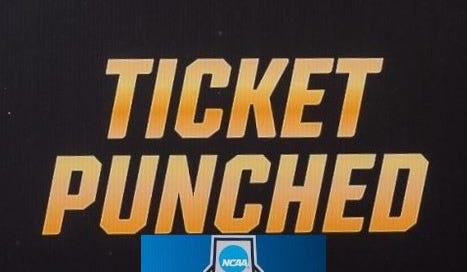


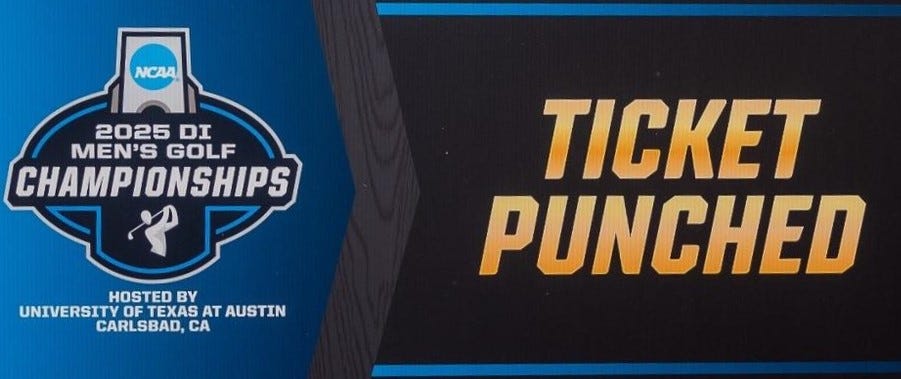






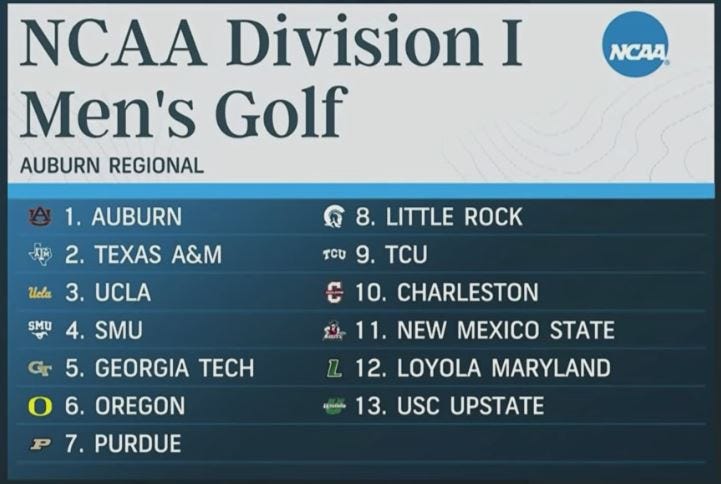
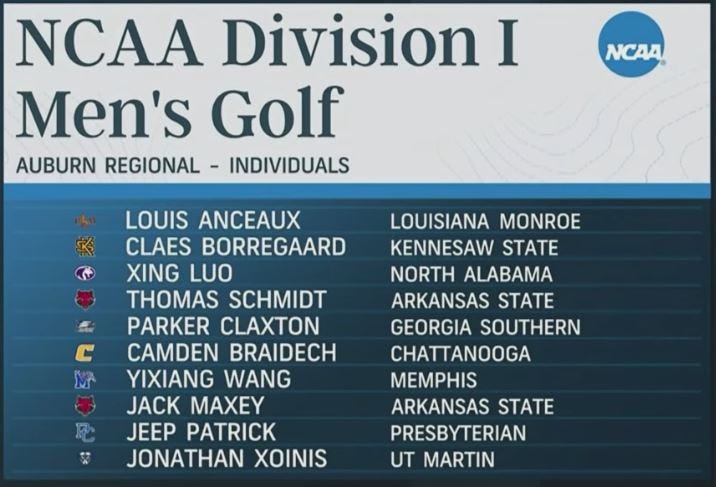

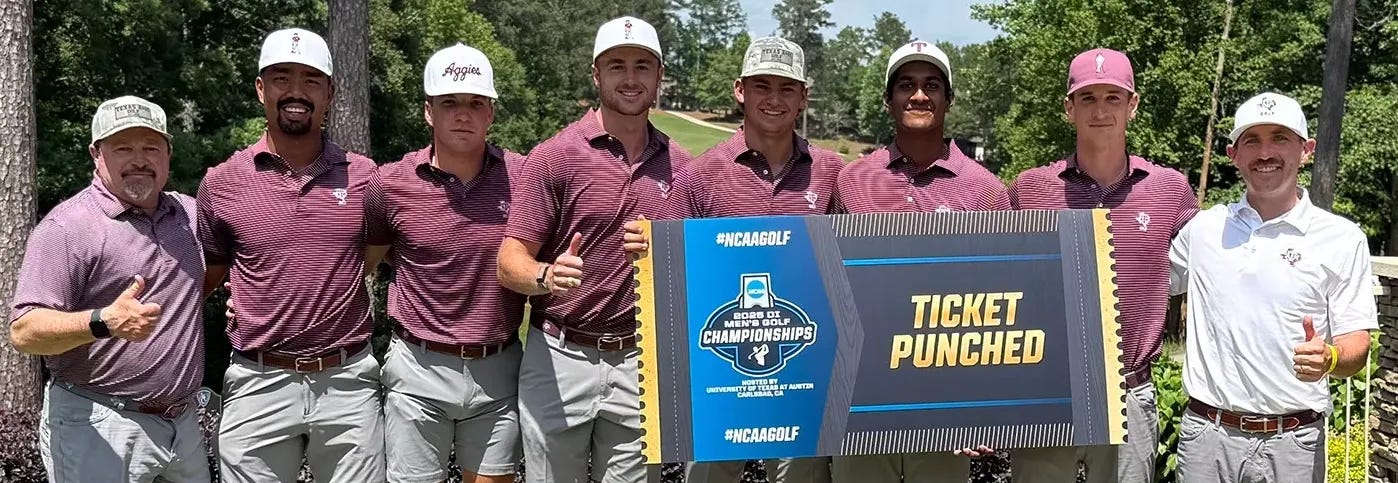
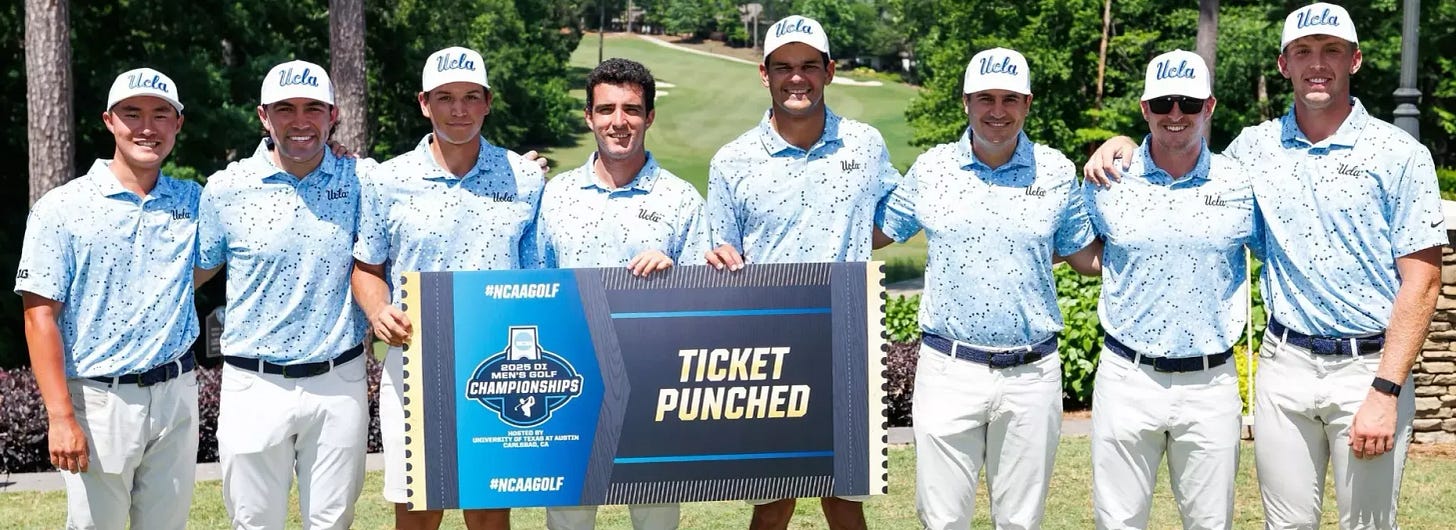

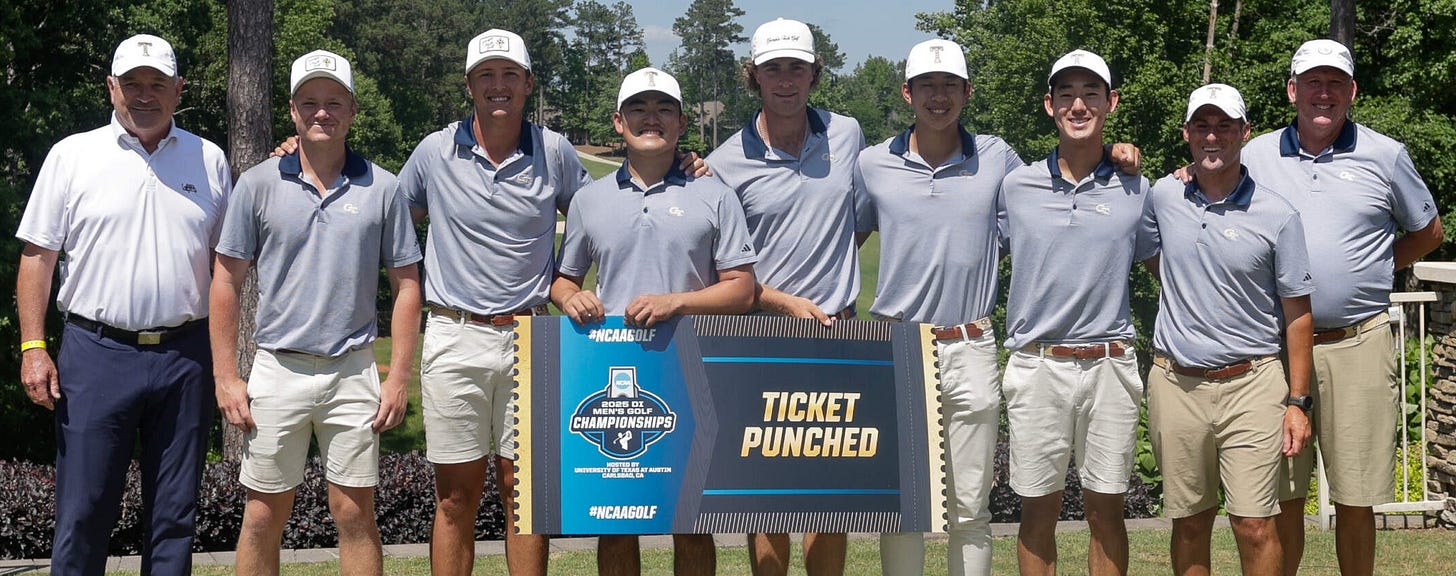
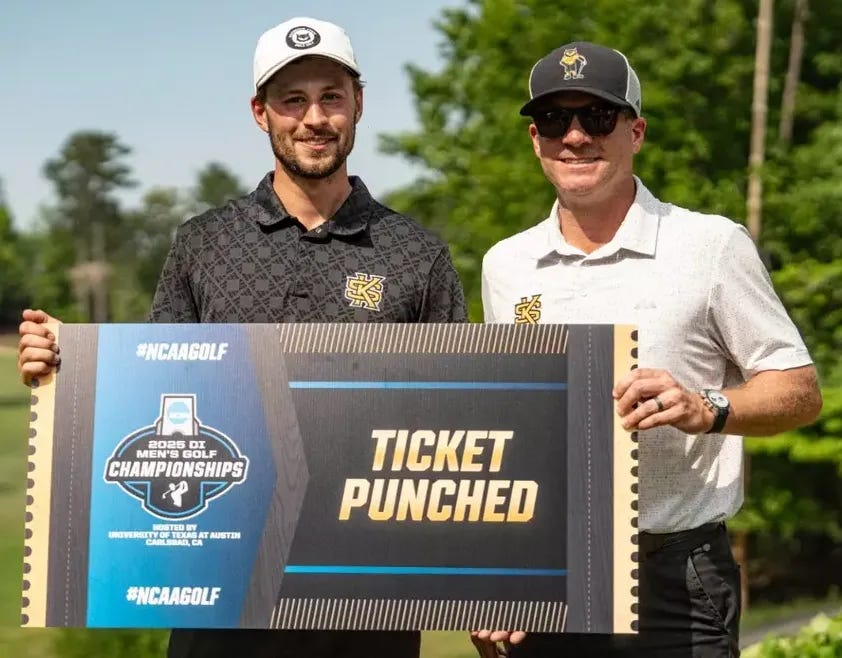


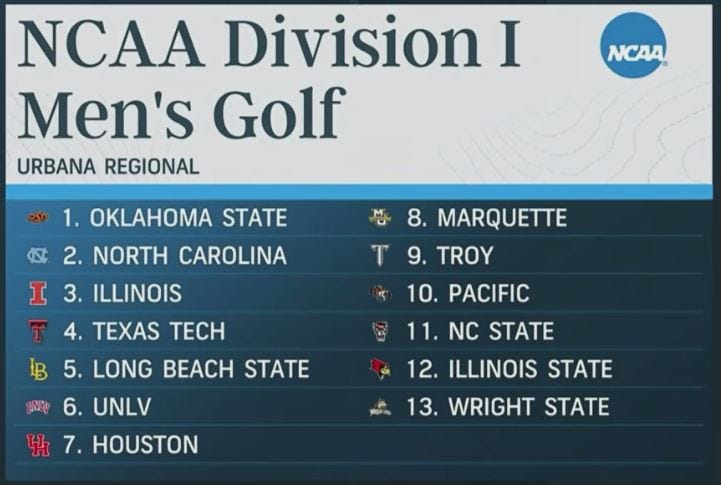
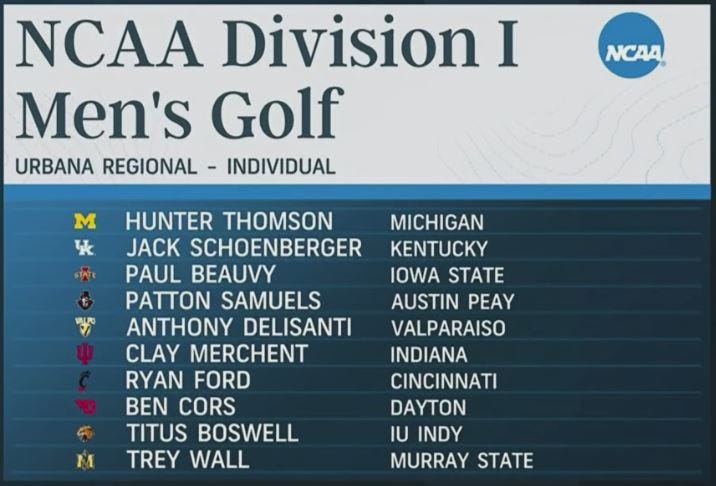


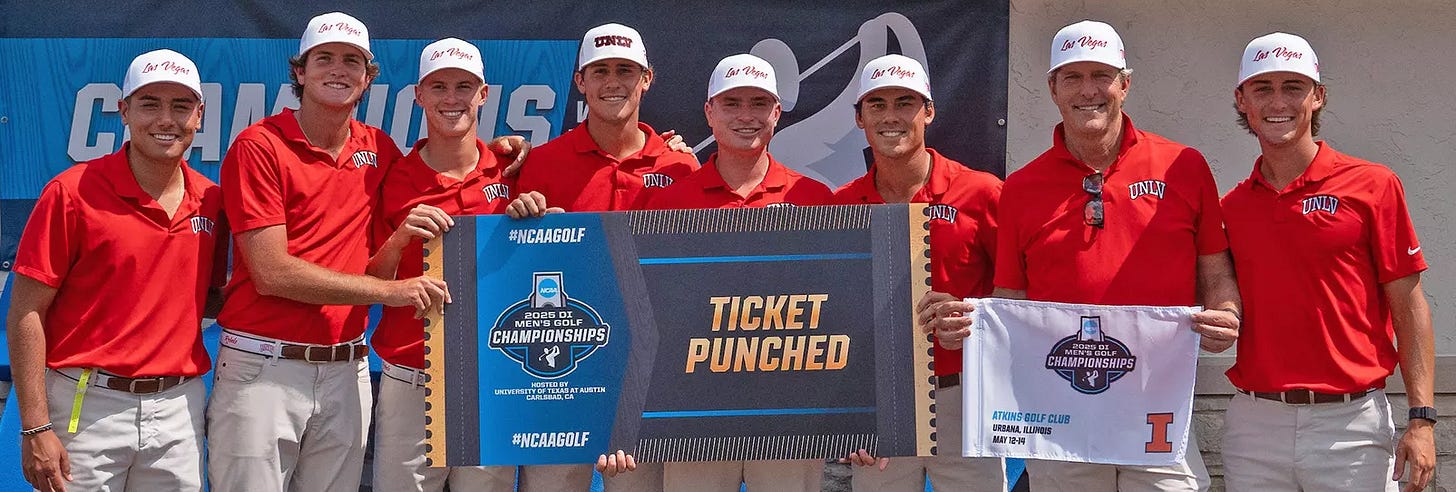
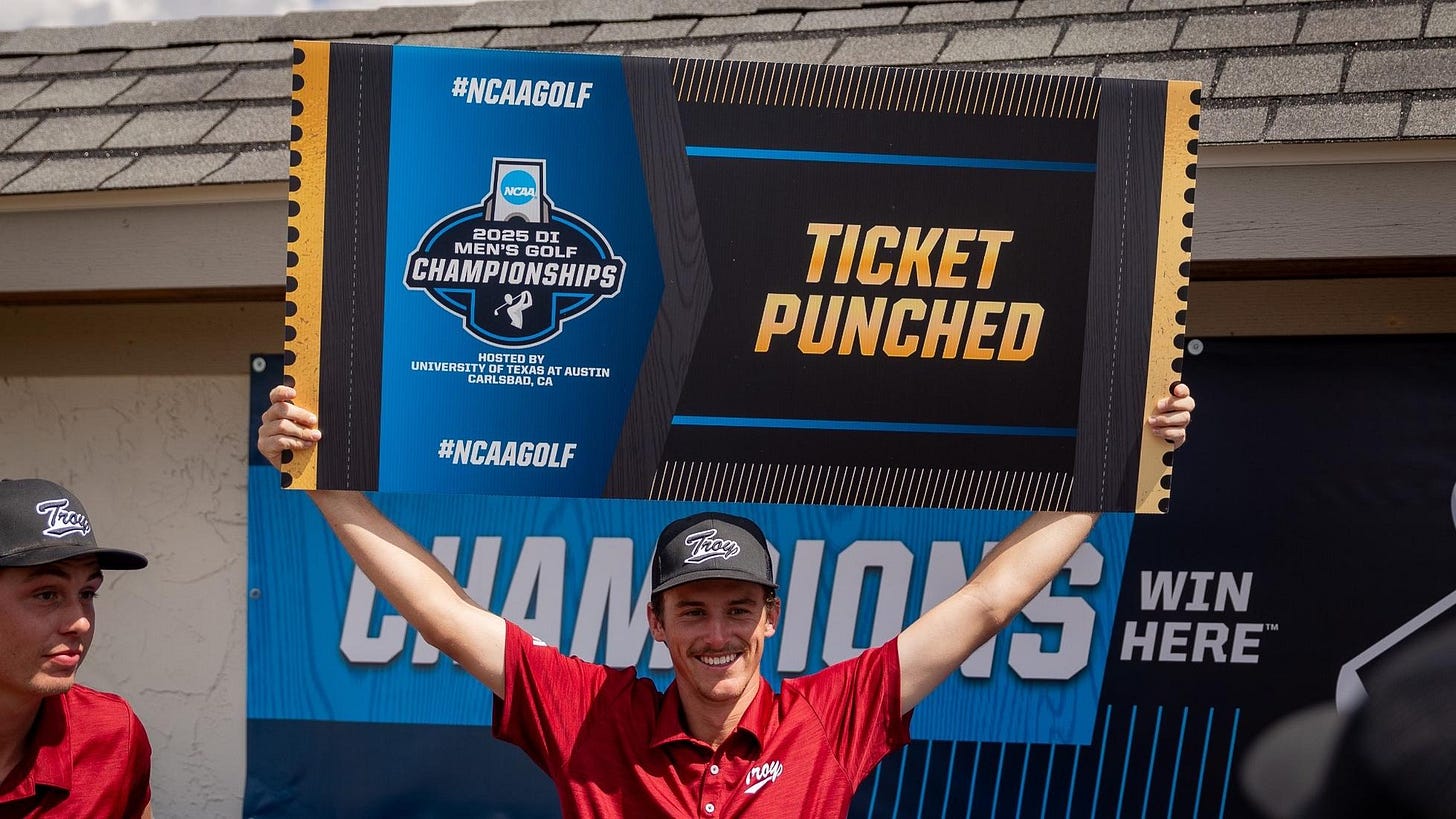

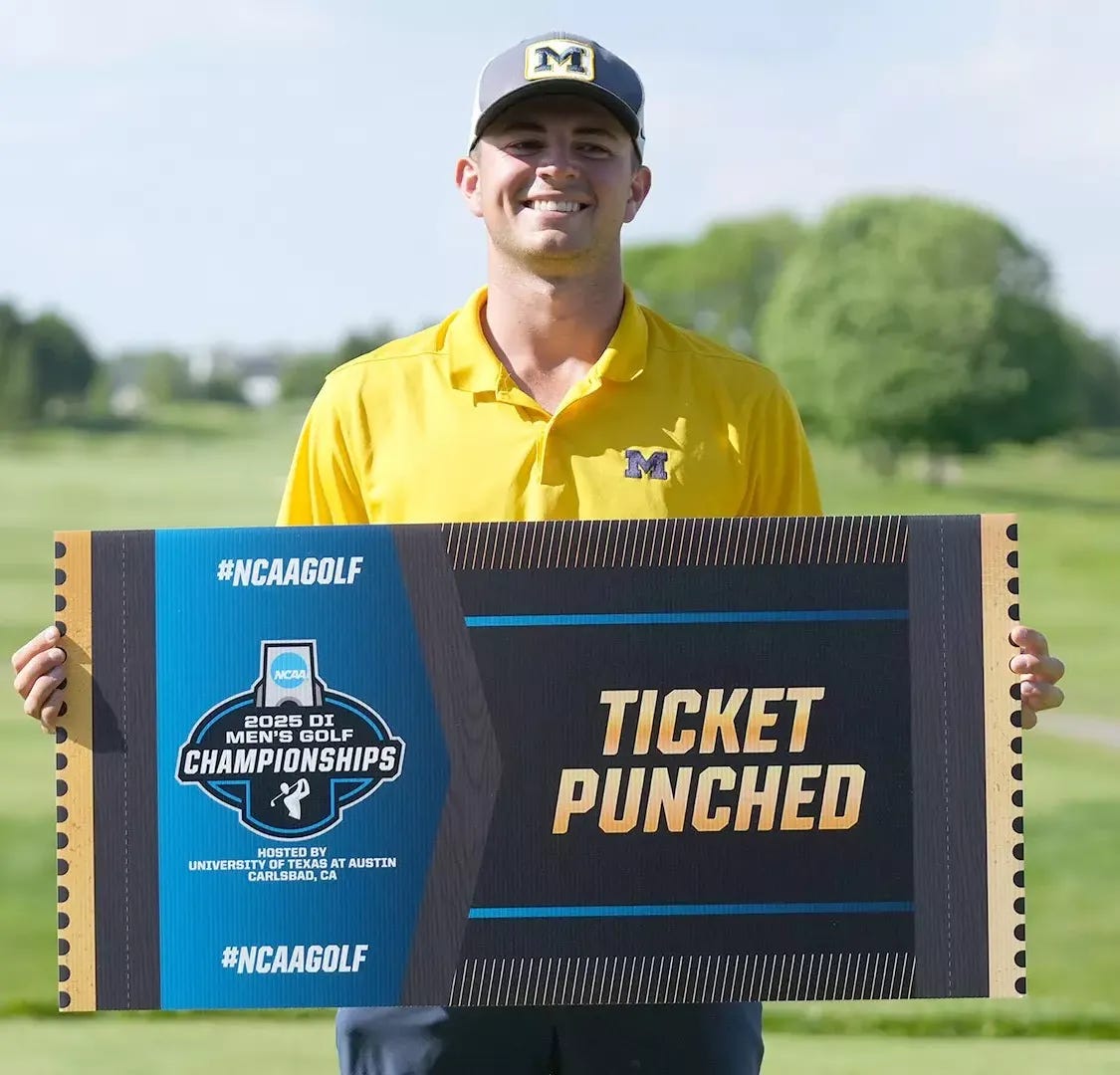


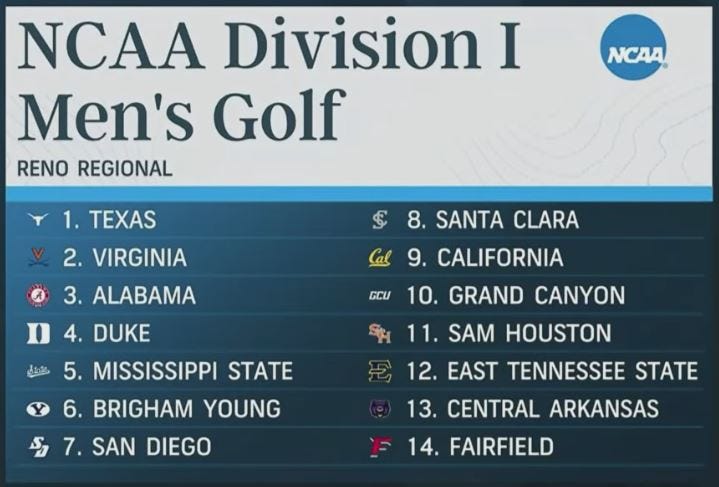
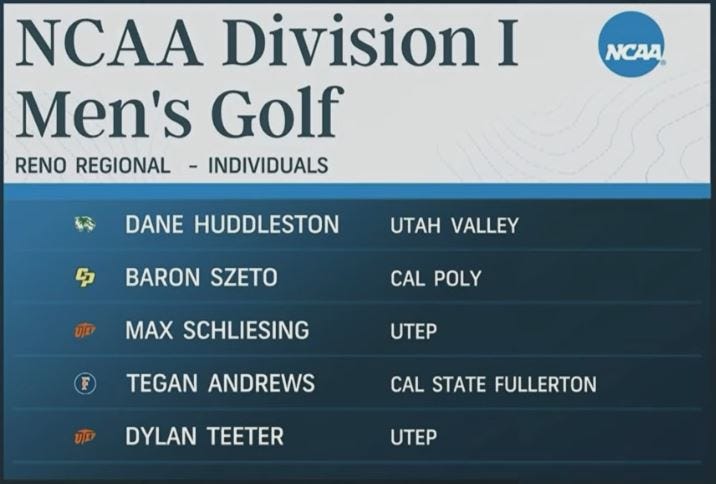
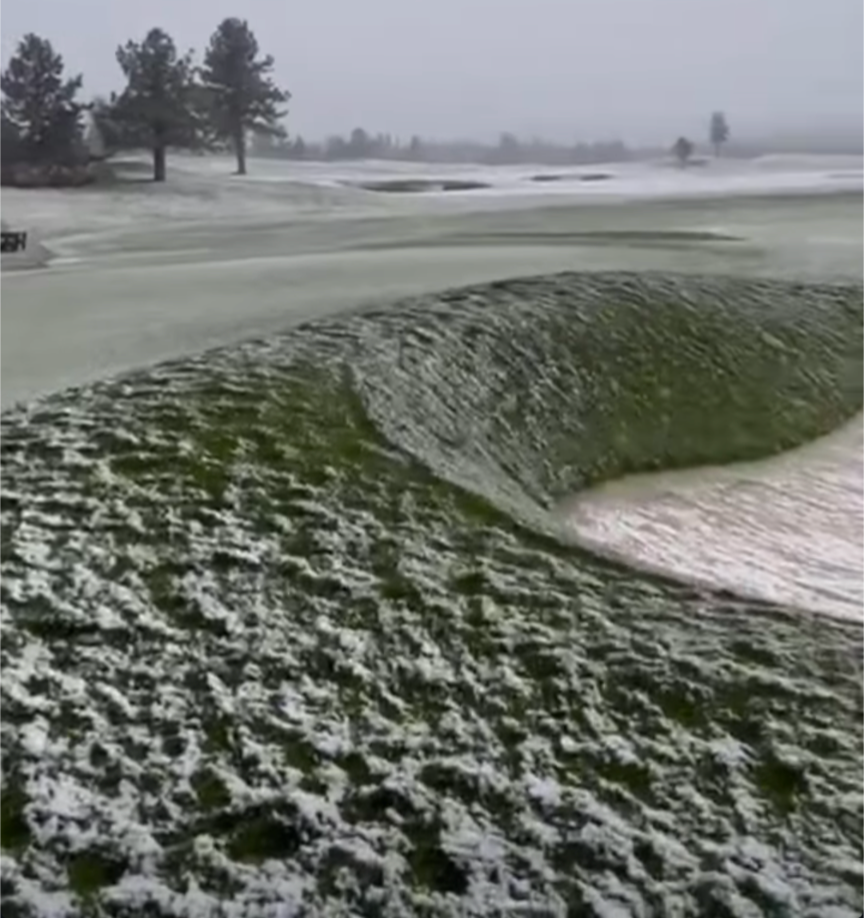
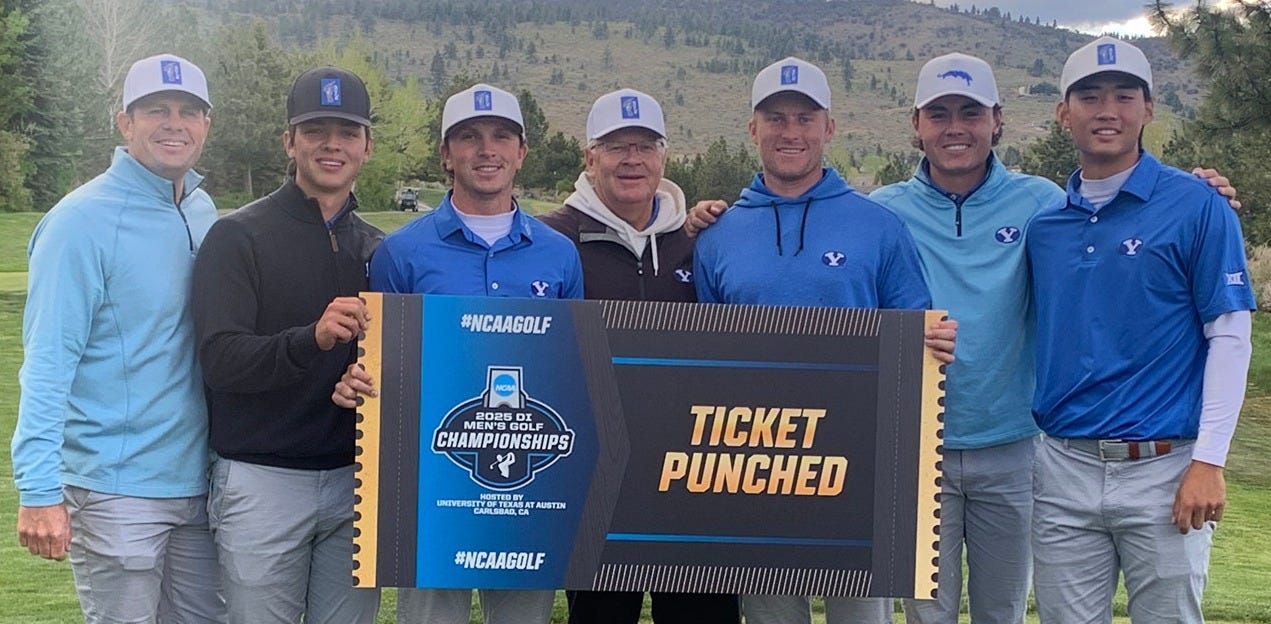
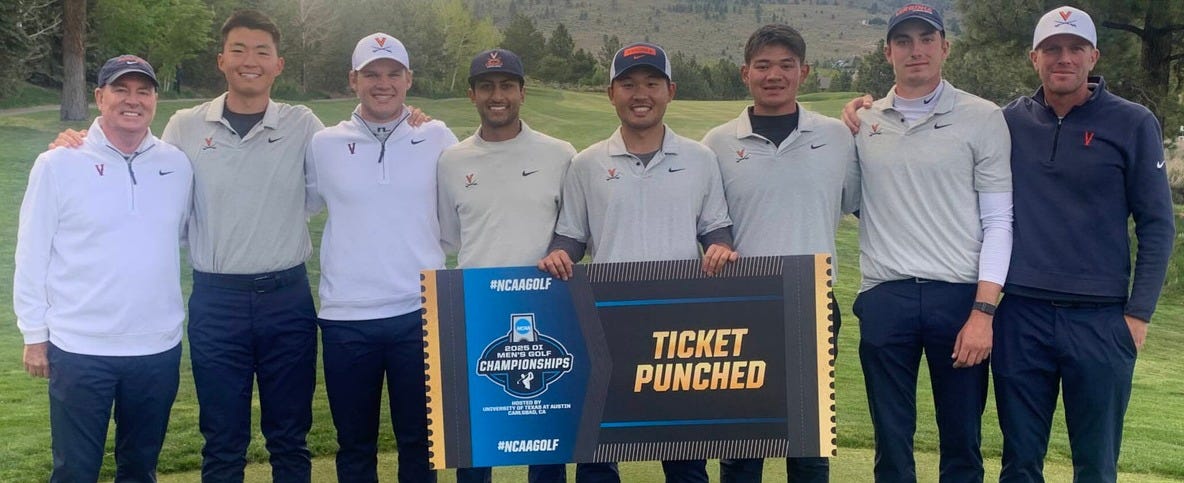
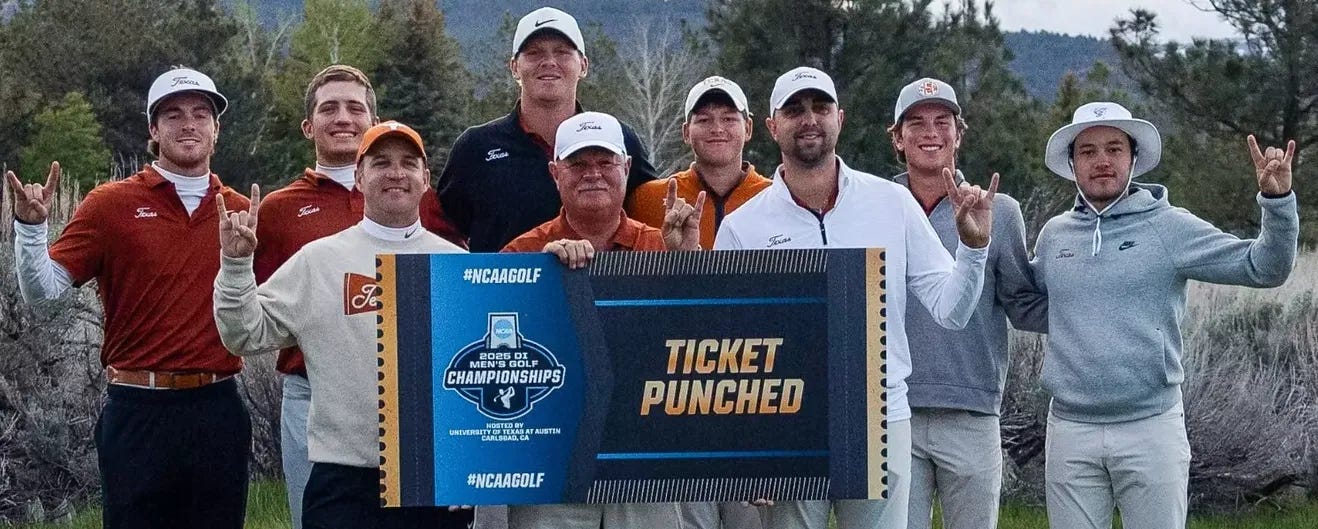
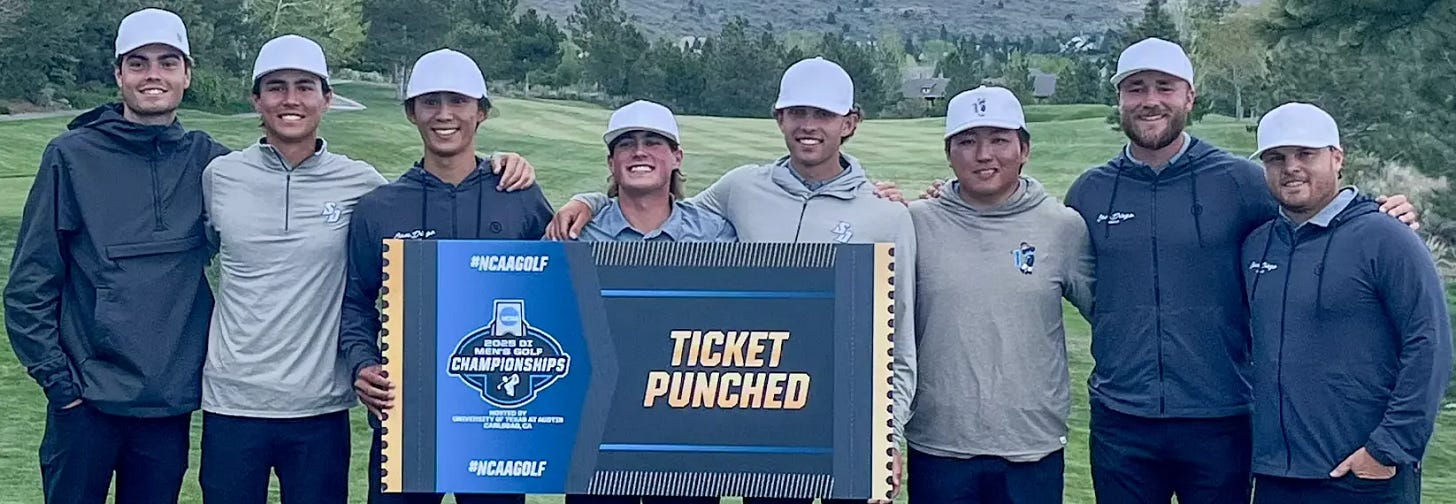
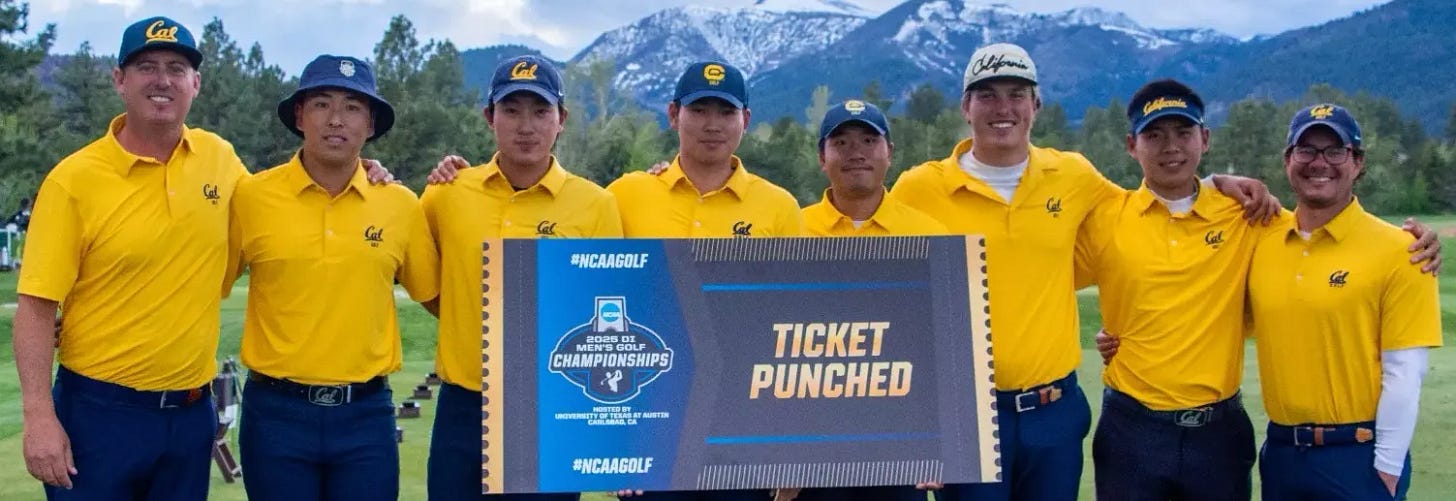
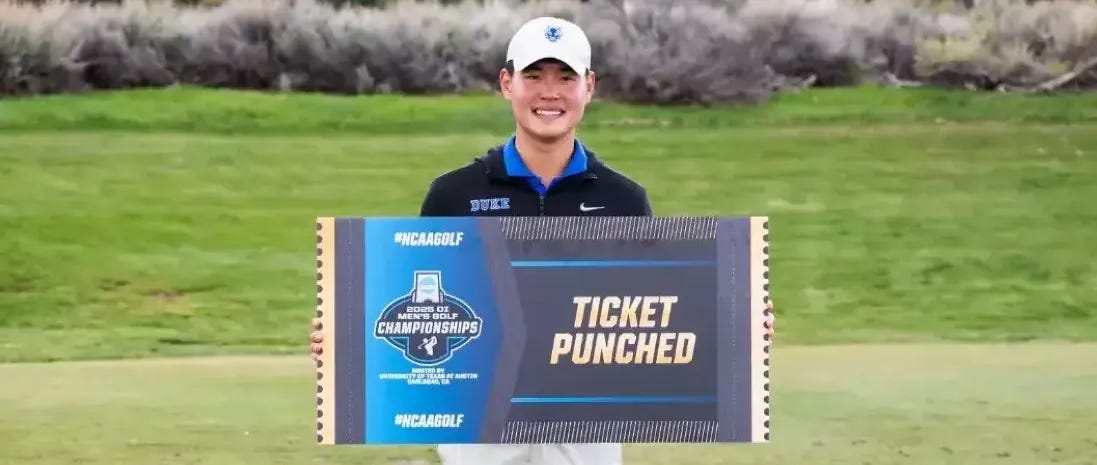


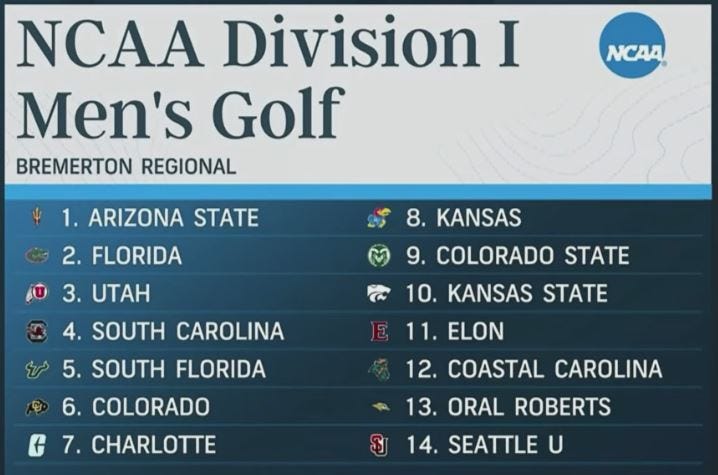


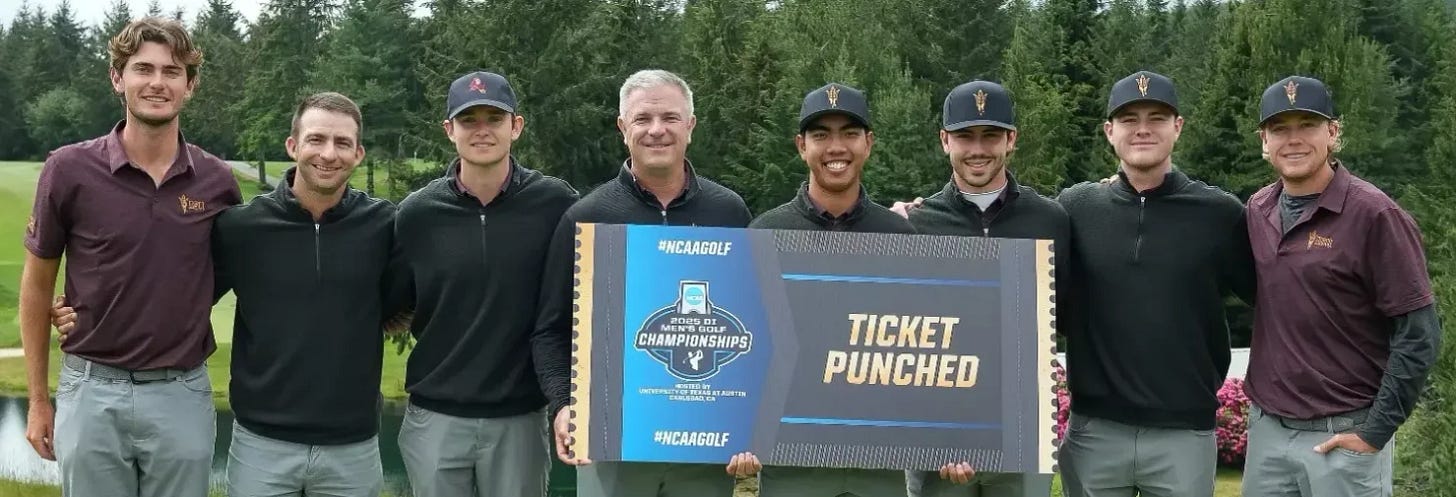



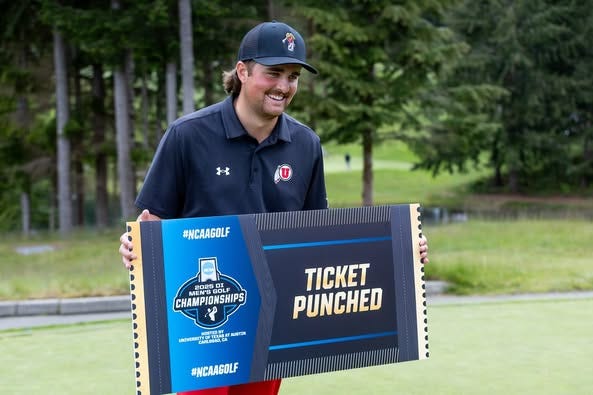


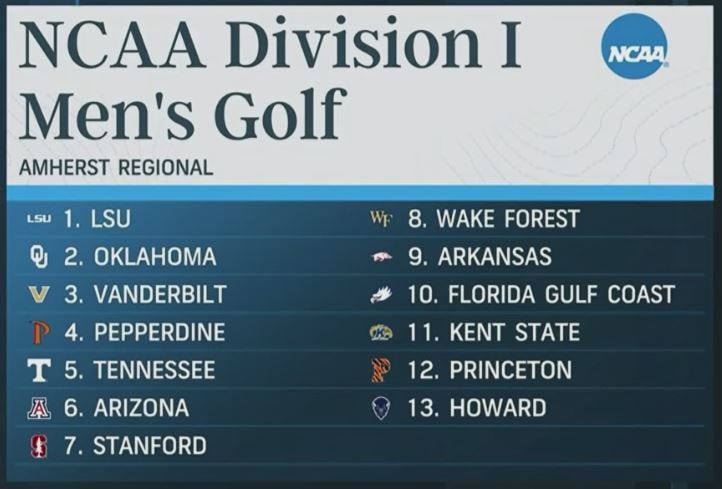
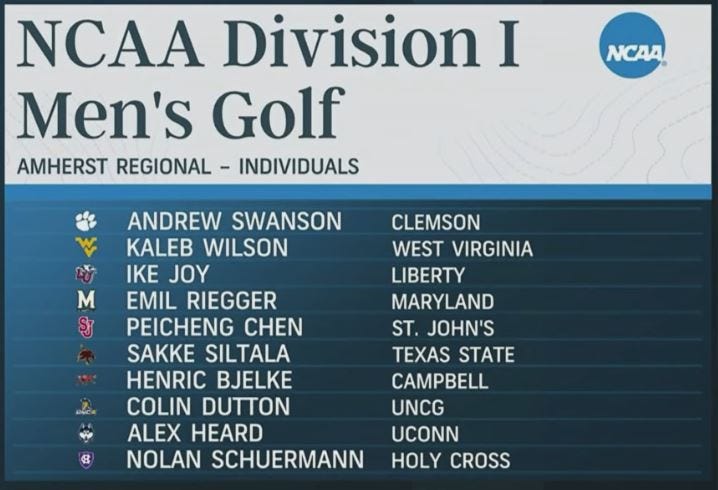
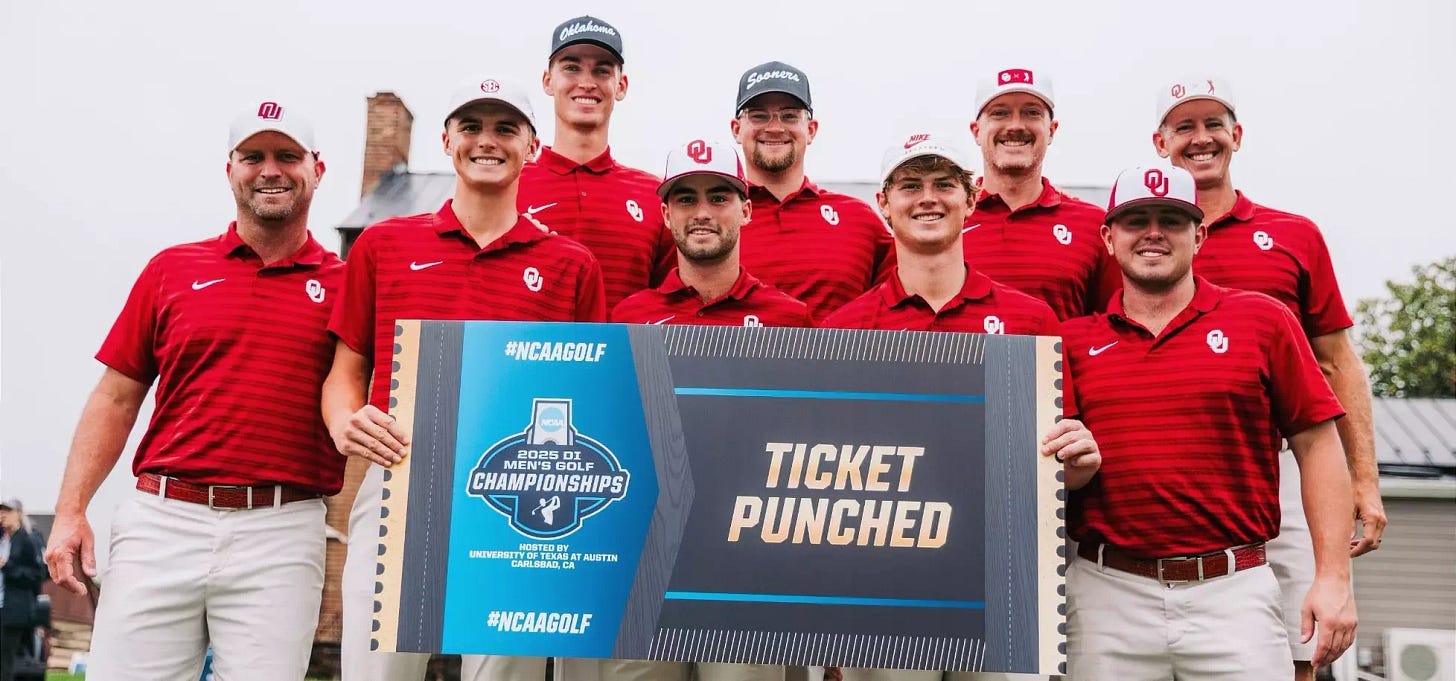
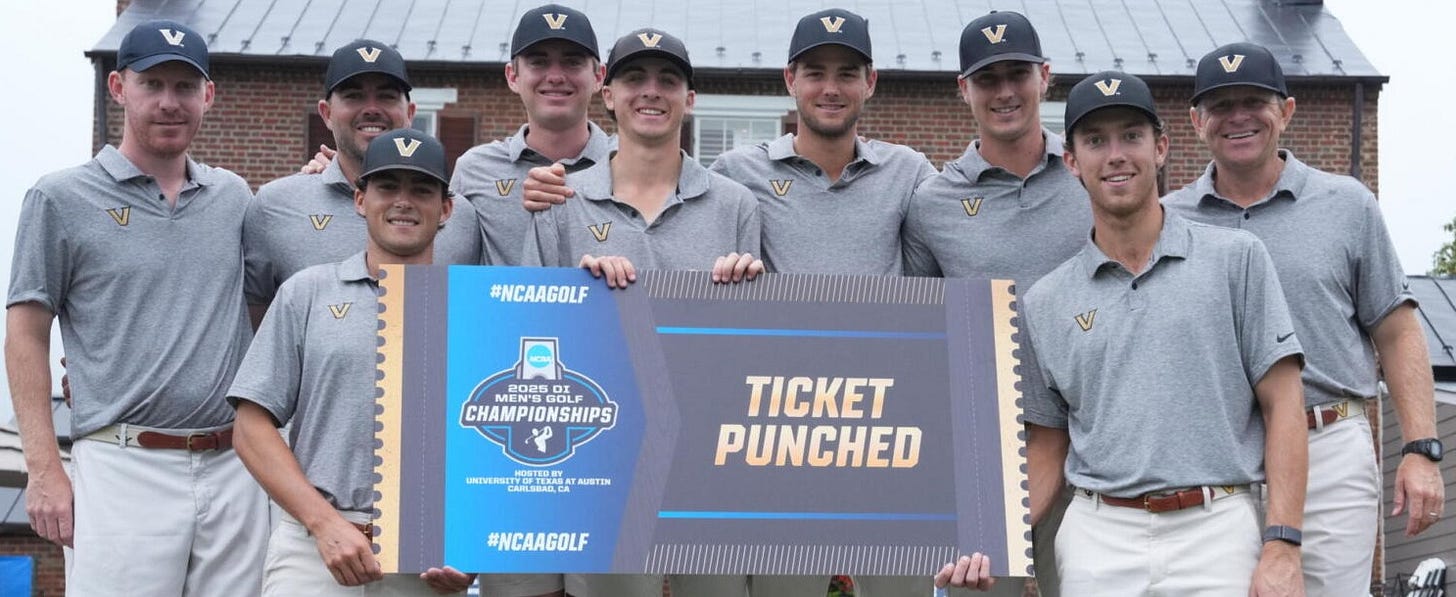
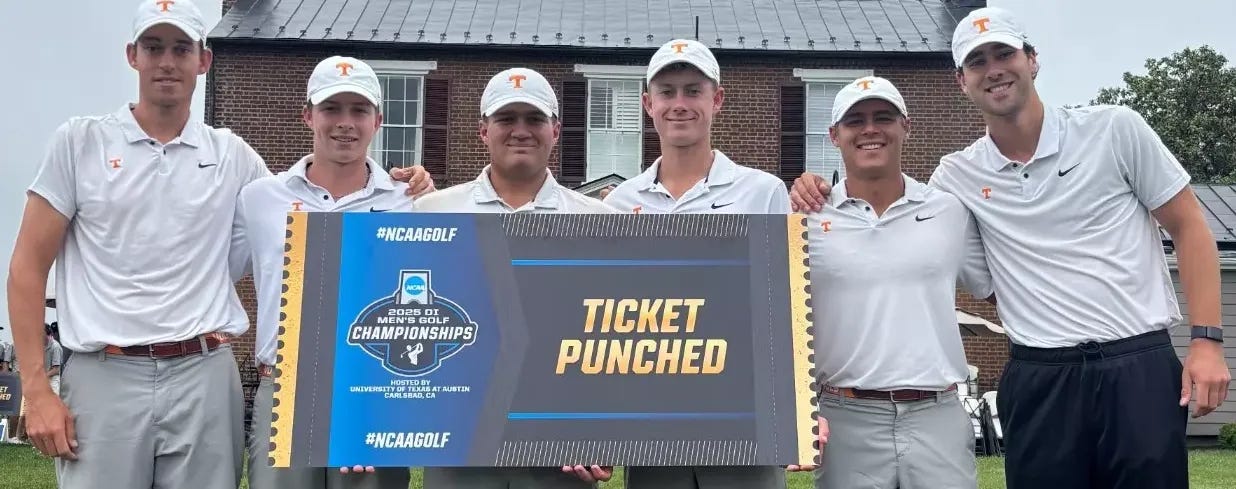

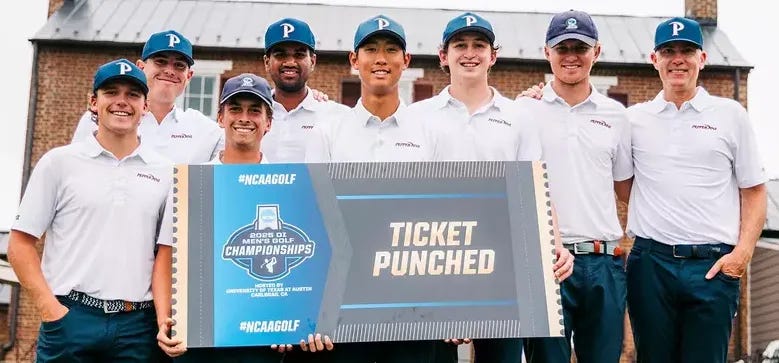





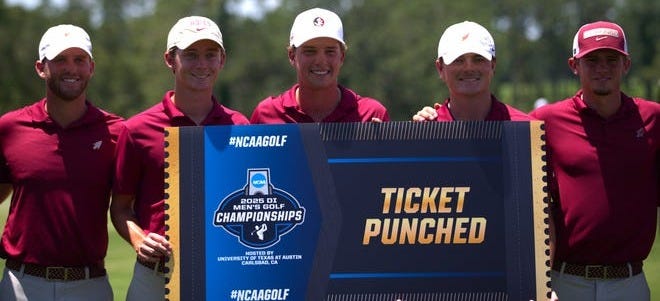


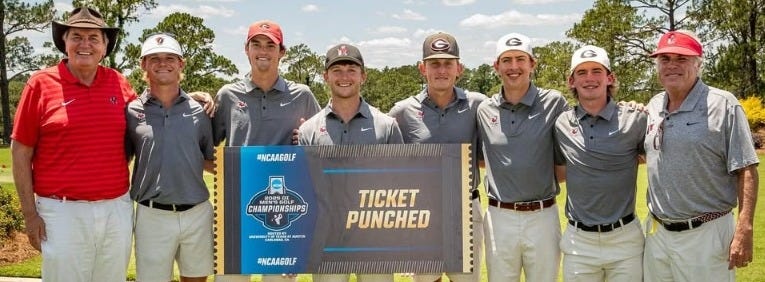





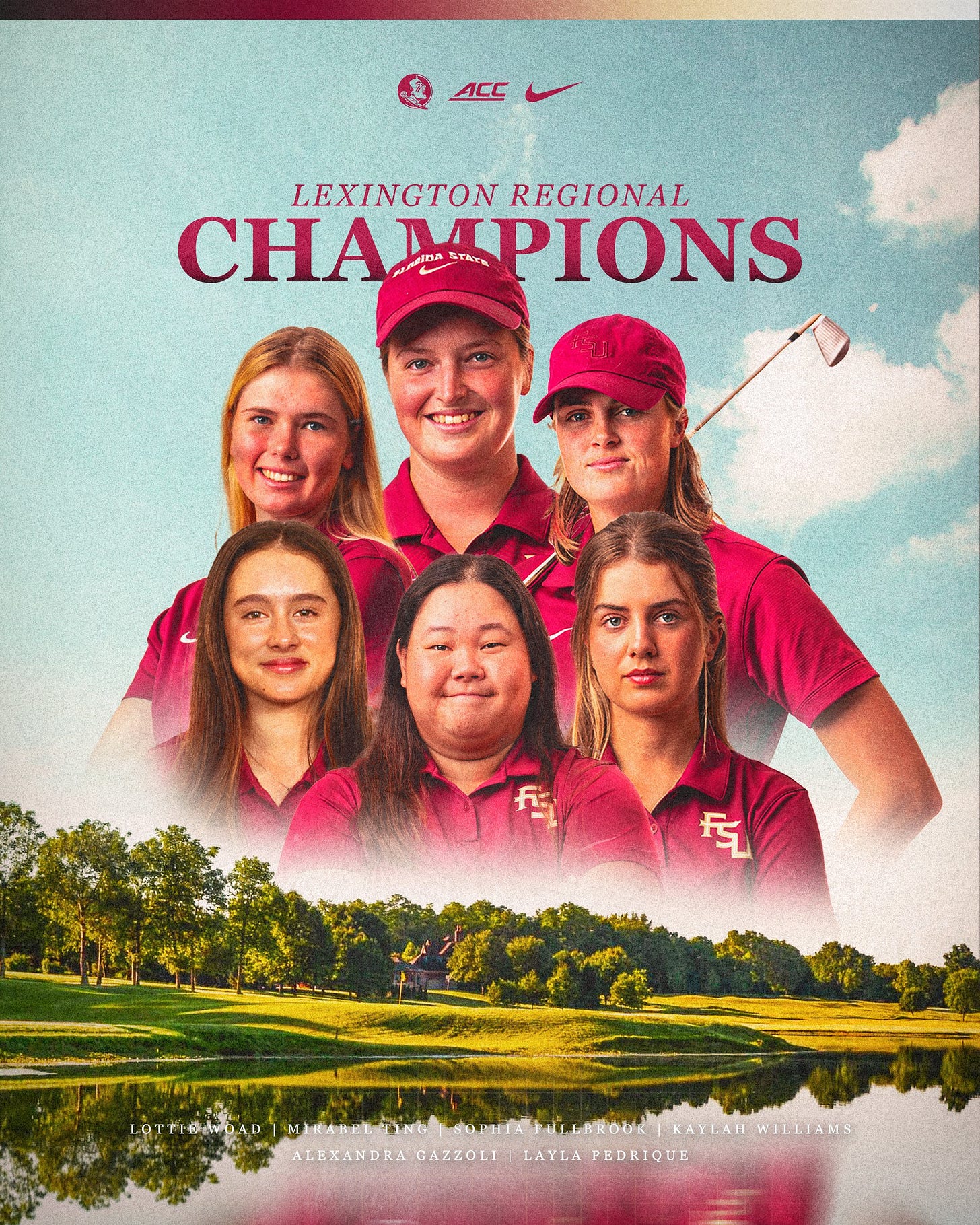
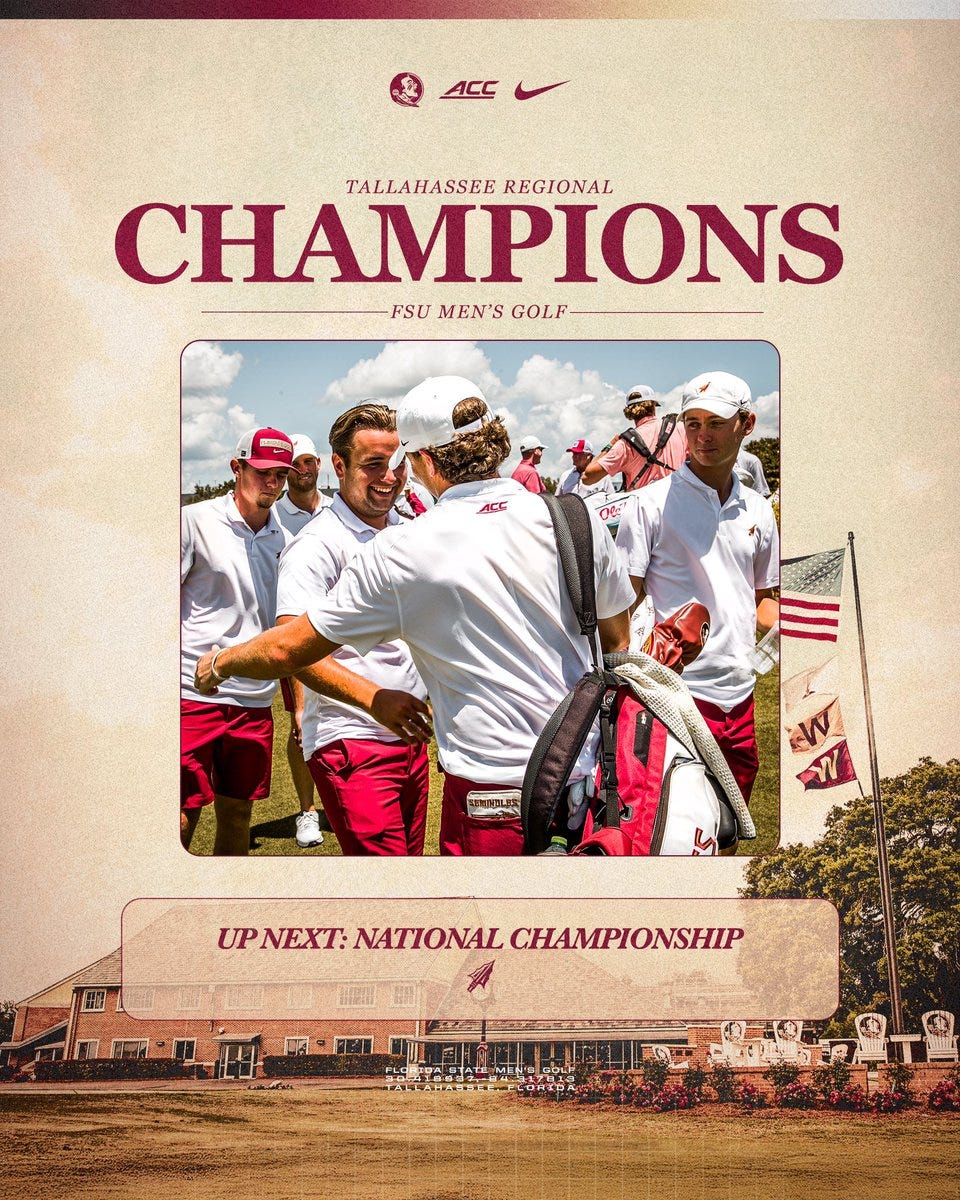
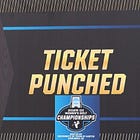
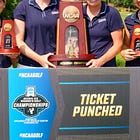
War Eagle 🦅